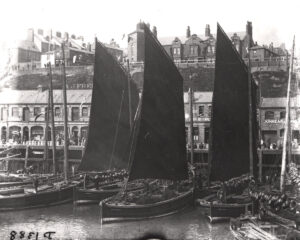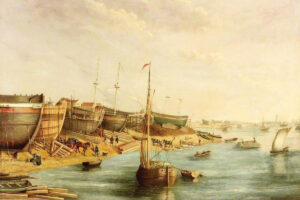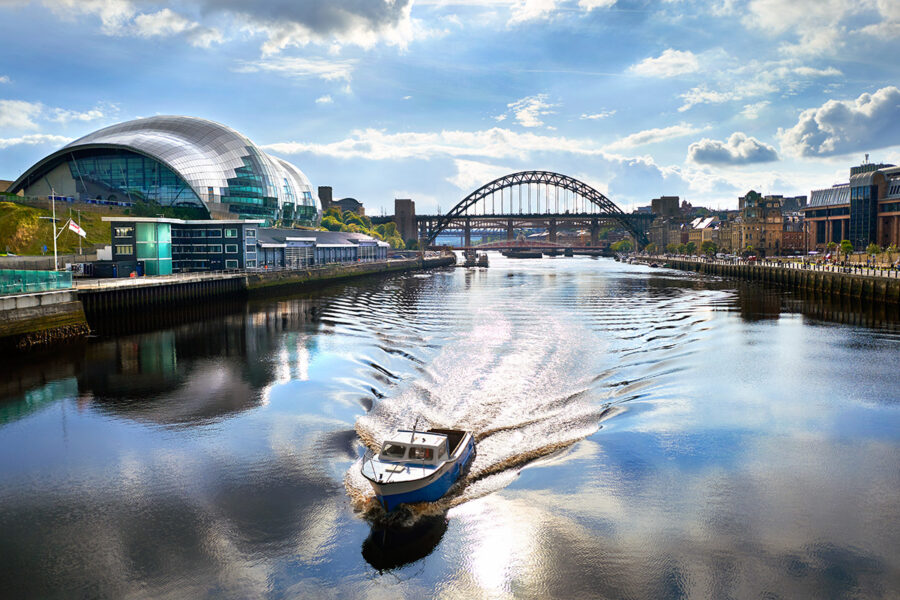North East historian Dan Jackson takes a look at the history of one of the region’s longest-running maritime businesses, as Sunderland Marine marks its 140th anniversary
I was very pleased to be invited by Sunderland Marine – now part of marine insurer North P&I, located on Newcastle’s quayside – to explore the long history of this fascinating business.
As a historian of the North East, I’m always fascinated by the cultural and commercial legacy of our traditional industries, and marine insurance has an important and enduring place in our history.

Herring boats at North Shields in around 1890, during the fishery’s boom era.
When I first delved into North’s archive for its 160th anniversary in 2020, I was struck by how closely its story is the story of the North East too – especially how dangerous industries led to innovation and mutual support – and how this was based on a deep-seated instinct for co-operation in the region, as well as a fierce local pride.
North now has over 12% global market share – meaning it insures one in every eight merchant ships on the planet – and through its Sunderland Marine brand, North is also a leading insurer of small craft and fishing vessels.
The story of Sunderland Marine begins in the bustling streets of Wearside in the 1860s. Sunderland was a Georgian boom town at the heart of the Great Northern Coalfield.
Ships had been built on the Wear since 1346, but the booming coal trade led to an explosion of shipbuilding on 18th- and 19th-century Wearside. By 1815 it was already the leading builder of wooden sailing vessels in Britain, and by mid-century a third of the UK’s ships were built in what the Sunderland Herald called ‘the greatest shipbuilding port in the world’.

By 1882, when Sunderland Marine was founded, the Tyne ports were thriving on the back of the coal-mining, shipbuilding and fishing booms.
Competition from the railways led to the development of more efficient steam collier ships, with the launch of the Loftus on the Wear in 1852. This in turn sparked an explosion in all kinds of North East shipbuilding and maritime traffic, exporting coal and manufactured goods all around the world.
But this world was still highly dangerous. Ship losses were frequent, even close to the shore – hence the invention of the lifeboat in South Shields in 1789, the formation of the world’s first Life Brigade in 1864 at Tynemouth, and the reforms of Samuel Plimsoll in the 1870s, who based his analysis of maritime safety on the fate of Sunderland ships.
Local shipowners had formed small insurance clubs since the 18th century, and a group from Wearside’s tight-knit commercial community came together in 1882 at the premises of R Hudson & Sons on John Street in Sunderland to form the Total Loss Mutual Steamship Insurance Company.
This coincided with a fishing boom, spurred on by the first application of steam technology to trawling in 1860, when a steamship towed two Sunderland- based sailing trawlers into the rich fishing grounds of the North Sea.
Herrings in particular were a cheap source of protein which, thanks to the railways, could now be exported quickly to the expanding industrial towns. Alongside this, the kipper, invented in North Shields, was soon found on every upper-class breakfast table in the land.
By 1916, Sunderland Marine had become the largest insurer of fishing vessels in the UK, and one of the vessels it insured, the Moulmein, was even shelled by confused Russian sailors in 1904 as its Baltic fleet took the long way round to fight the Japanese in the straits of Tshushima, between Japan and Korea.

By the middle of the 19th century, a third of the UK’s ships were being built on the Tyne.
The early 20th century saw a global decline in demand for herrings (once a major export industry), but this was replaced by a new British obsession: fish and chips! By 1920 there were 25,000 such shops across the UK, consuming 150,000t of whitefish annually.
However, the traditional British fishing industry faced growing international competition, and by the 1960s Sunderland Marine was only insuring 270 British boats. So the firm began to diversify and seek new markets, building a presence first in the Netherlands in the 1970s, followed by Australia, Canada, New Zealand and the USA in the 1980s – even opening a branch in Alaska in 1996.
The Sunderland Marine brand name lives on today as a leading insurer of hull and machinery, P&I and personal accident insurance for commercial fishing vessels, small passenger craft, tugs, barges and harbour service vessels – now with over 8,000 vessels covered and 140 years of experience.

Senior underwriting executive Holly Rowley presenting Rory Brickley with Whitby Fishing School’s Apprentice of the Year award in 2021.
That respect for the industry’s history still continues to shape the marine insurance business. To this day, members renew their policies on 20 February each year, which is when sailing ships were traditionally taken from their winter lay-ups and made ready for trade with the ice-free ports in the Baltic.
In September, North will mark Merchant Navy Day and the enduring role of maritime key workers in the global supply chain, and the firm recently ringfenced £40,000 of its North 150 Fund for maritime charities, providing grants for seafarers and their families, as well as much-needed mental health resources for those working at sea.
North Easterners can be proud of that heritage, and how Sunderland Marine and North P&I are continuing and evolving that legacy today.
“Our business has changed with the times, but the dangers and unpredictability of working at sea remain a constant,” says Craig McBurnie, director of Sunderland Marine.
“We are committed to promoting safety and training initiatives for the fishing community and supporting the future of the industry.”
As Sunderland Marine enters its 140th year, it can reflect on a proud history at the heart of the region’s commercial life, and its enduring role as a key player in the global maritime sector.
You can find out more about how Sunderland Marine supports fishing vessels, as well as coastal and other specialist vessels, here. Discover more fascinating history with our image gallery below…
This story was taken from the latest issue of Fishing News. For more up-to-date and in-depth reports on the UK and Irish commercial fishing sector, subscribe to Fishing News here or buy the latest single issue for just £3.30 here.








